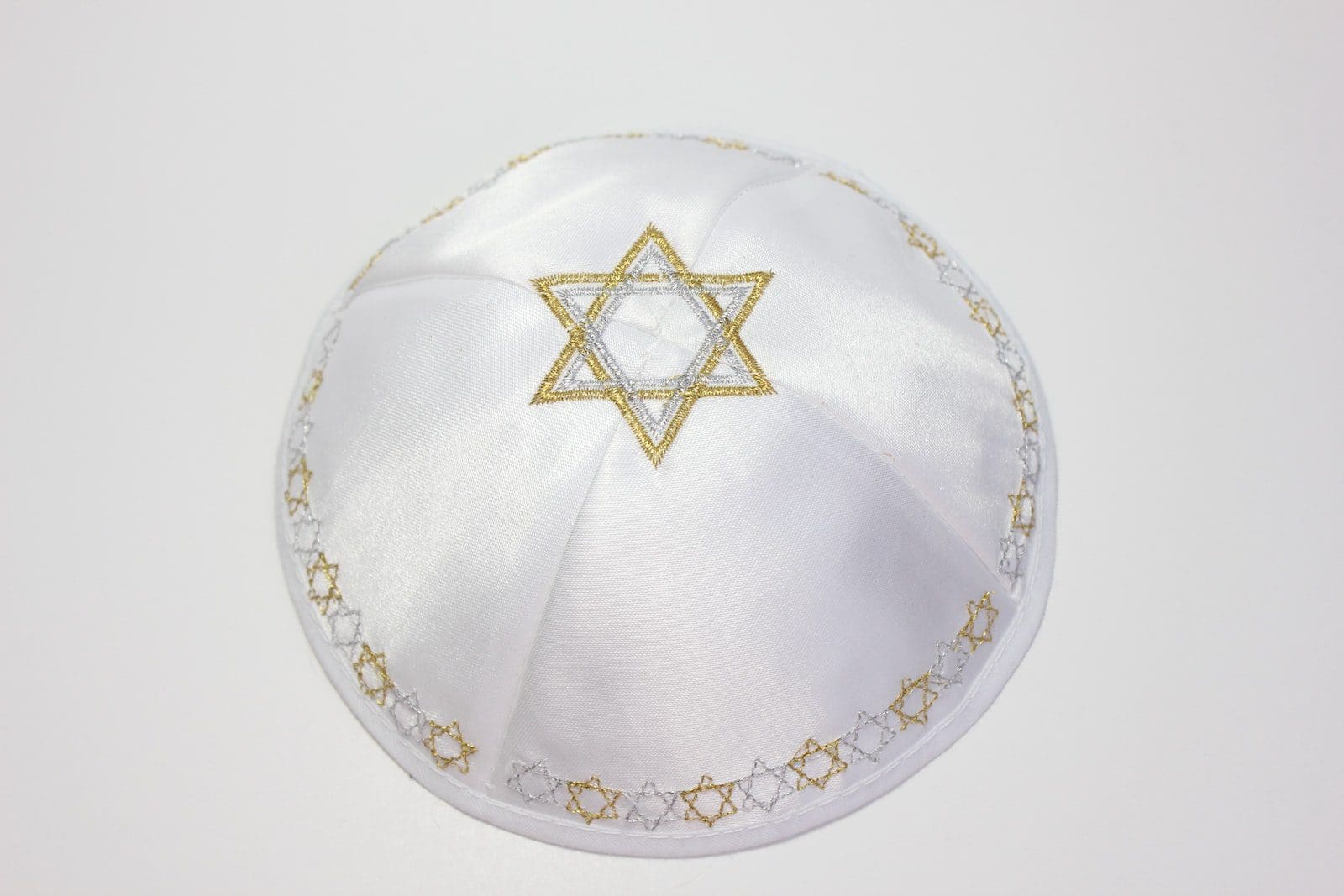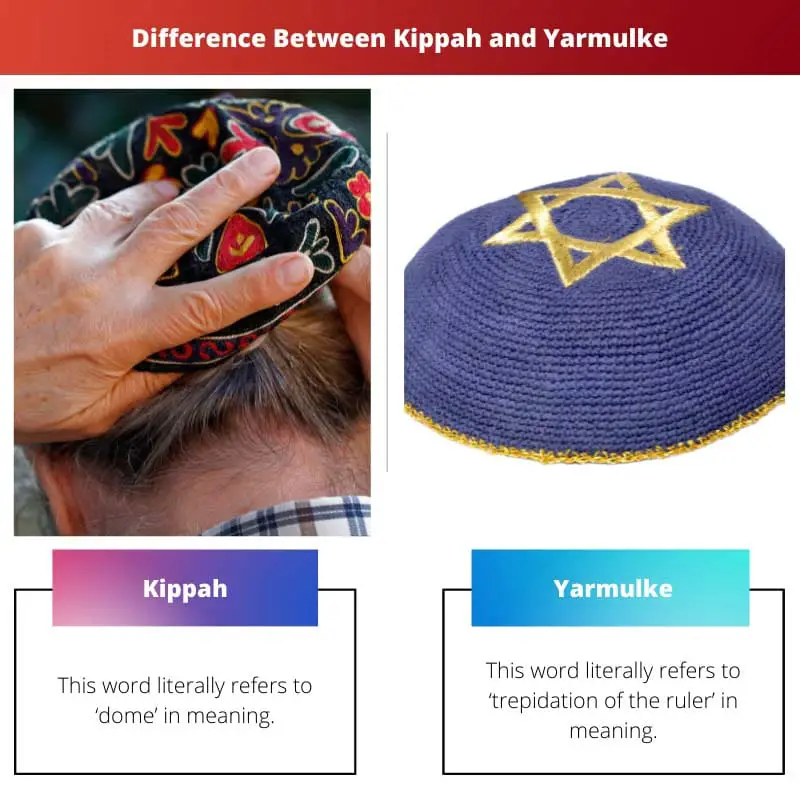Many civilizations and traditional customs call this world home. A wide range of customs and traditions can be found everywhere, from languages to culinary preferences, clothes to celebrations.
Clothes, like any other phenomenon, play an important role in cultural identification. They not only determine it, but they also aid in the preservation of the culture.
Key Takeaways
- Kippah is a Hebrew term; Yarmulke is Yiddish, but both describe a skullcap worn by Jewish men.
- Wearing these skullcaps shows respect, reverence for God, and acknowledgment of a higher power.
- Styles, materials, and designs vary across communities and occasions, reflecting cultural and personal preferences.
Kippah vs Yarmulke
Kippah and yarmulke are two words for the same head covering worn by Jewish men. The word “kippah” is Hebrew, and the word “yarmulke” is on Yiddish language – a language once spoken by Jews. They both refer to a small, round cap worn to cover the head as a sign of respect and reverence.

Taken from the Hebrew language, Kippah is a word that literally means ‘dome.’ In some other languages and areas, people refer to it as prison also because the prisons used to have domes on their roofs earlier in history.
While on the other hand, Yarmulke refers to a similar variety of headcaps but gets categorized differently due to being taken from another language, Yiddish.
Comparison Table
| Parameters of Comparison | Kippah | Yarmulke |
|---|---|---|
| Meaning | This word literally refers to ‘dome’ in meaning. | This word literally refers to ‘trepidation of the ruler’ in meaning. |
| Origin | Originated from the Hebrew language. | It originated from the Silvis language and further derived from the Yiddish language. |
| Purpose | As per the religious texts and lectures, Jews are presumed to wear this cap to fulfill their obligation towards their religion. As their religion mandates it to cover their heads during all times. | No such specific purpose is mentioned anywhere. It is just a cultural showcase. |
| Mostly Worn By | Orthodox Jews community is mostly seen wearing this head cap. | Ashkenazic community of the people professing Judaism is mostly seen wearing this cap. |
| Another Name | Kippot is another term used for this head cap. | Yamalka or Yamalki are some of the common names used in place of Yarmulke. |
What is Kippah?
In the Hebrew language, Kippah is a word referring to a dome.
It denotes this particular meaning because it is a cap to be worn over the head, and it symbolizes the shape of a dome. In another language which is Talmud, it also means Prison.
Certain sections of the community of Jews were raised to believe that the head caps were necessary to wear because the head was supposed to be covered due to religious obligations.
When multiples of Kippah caps are referred to, the word Kippot is used to convey the meaning. With the passage of time, these caps have seen multiple evolutions and upgrades.

What is Yarmulke?
Yarmulke is just another term referring to the Kippah caps only. The main difference between this particular cap and Kippah is that Yarmulke is the term denoting another linguistic concern.
The Aramaic language has two primary words: Yarei Malka and Yarei Malka. It essentially indicated the king’s fury. This headgear was worn by the Ashkenazic group of persons who practiced Judaism on a daily basis.
It used to be the ethnic clothing of those who professed their religion, but with time, this cap has evolved into a variety of colors and textures, including yarn, wool, and silk.

Main Differences Between Kippah and Yarmulke
- Orthodox Jews community is mostly noticed to wear Kippah, while Yarmulke is mostly found in the Ashkenazic community of the people professing Judaism.
- Another name for Kippah is Kippot, while Yamalka or Yamalki are some of the common names used in place of Yarmulke.

- https://rai.onlinelibrary.wiley.com/doi/abs/10.1111/1467-9655.13130
- https://www.tandfonline.com/doi/abs/10.1080/00107530.2007.10745922

This in-depth comparison brings clarity to the distinct nomenclature and cultural usage of Kippah and Yarmulke among Jewish communities.
Yes, learning about the variations and the symbolic importance associated with these headwear is truly eye-opening.
The explanations and references in this article offer valuable insights into the Kippah and Yarmulke, highlighting their religious and cultural connotations.
Certainly, the scholarly resources and discussions presented in this article enhance our understanding of Jewish customs.
I think it is interesting to learn about the differences between Kippah and Yarmulke. It is a way to understand someone else’s culture.
This scholarly article presents a comprehensive analysis of the Kippah and Yarmulke, underscoring their cultural and linguistic underpinnings with scholarly rigor.
Absolutely, the detailed examination of the cultural and historical roots of Kippah and Yarmulke offers a profound understanding of Jewish traditions.
The historical and etymological delineation in this article provides a comprehensive understanding of the religious and cultural symbolism of Kippah and Yarmulke.
The article accurately distinguishes between the Kippah and Yarmulke, shedding light on their spiritual and cultural relevance.
Indeed, understanding the distinctions and the significance behind these head coverings enriches our knowledge of Judaic traditions.
The article effectively articulates the evolution and cultural connotations of Kippah and Yarmulke, providing a comprehensive overview.
Absolutely, the historical background and cultural implications are intricately detailed for a holistic understanding.
I couldn’t agree more, the cultural and linguistic significance is thoroughly discussed in this informative piece.
The article offers a detailed insight into the varying nomenclature and profound historical underpinnings of Kippah and Yarmulke, enriching our knowledge of Judaic traditions.
Absolutely, the scholarly elucidation enhances our understanding of the linguistic and cultural dimensions of these head coverings.
Indeed, the terminological discussions and historical context provide an illuminating examination of the cultural significance of Kippah and Yarmulke.
This article unveils the profound cultural significance of the Kippah and Yarmulke for the Jewish community.
Absolutely, the religious and cultural implications associated with these head coverings are truly fascinating.
This resourceful article captures the essence of the Kippah and Yarmulke, delineating the intricate nuances and cultural implications associated with these head coverings.
Indeed, the article presents a refined exploration of the historical, linguistic, and cultural dimensions of these headwear.
Absolutely, the comprehensive comparison clarifies the religious and cultural significance of Kippah and Yarmulke.
I had no idea about the historical and linguistic origins of the Kippah and Yarmulke. This was an enlightening read.
I agree, the etymological insights are truly captivating.